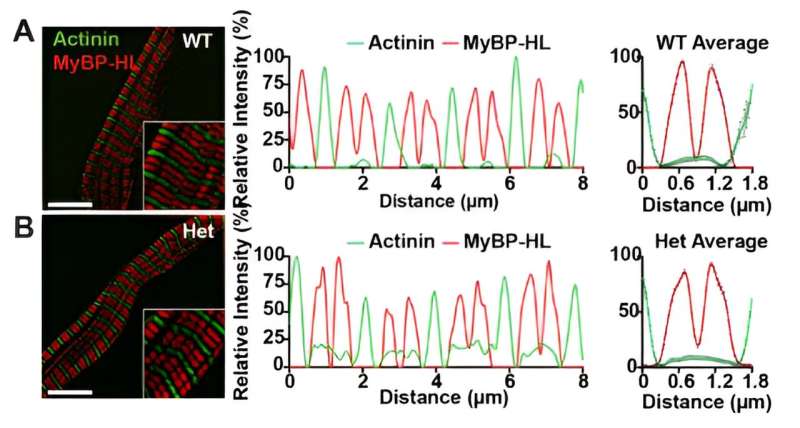This article has been reviewed according to Science X's editorial process and policies. Editors have highlighted the following attributes while ensuring the content's credibility:
fact-checked
peer-reviewed publication
trusted source
proofread
Novel protein interactions may serve as biomarker for heart disease

Investigators led by Elizabeth McNally, MD, Ph.D., the Elizabeth J. Ward Professor of Genetic Medicine and director of the Center for Genetic Medicine, have discovered previously unknown protein interactions in the heart's atrium that are critical for normal heart function, according to findings published in the Proceedings of the National Academy of Sciences.
The heart is divided into four chambers: two on the top (atrium/atria) and two on the bottom (ventricles), with one of each side of the heart. The ability of the heart's ventricles to pump oxygen-poor blood to the lungs and oxygen-rich blood to the rest of the body depends on the atria, which consistently refill the ventricles with blood.
The atria are also a main site for disease, notably atrial fibrillation, which occurs when the atria are no longer normally contracting and instead have fast, uncoordinated and irregular heartbeats, or arrythmia. This chaotic beating impairs the normal filling of the ventricles, and may eventually lead to stroke and even heart failure.
"We're starting to finally have good tools to look at the atria to recognize relaxation properties as being important and essential for the heart function as a whole. If the atria can't do their full job, then the ventricles can't do their full job," said McNally, who is also a professor of Medicine in the Division of Cardiology and of Biochemistry and Molecular Genetics.
However, the precise mechanisms regulating atrial contraction and relaxation have recently garnered more attention with the discovery of new previously unappreciated proteins, according to McNally.
In a previous study from the McNally laboratory published in Circulation, investigators discovered the MYPBHL gene and that mutations in this gene increases the risk of arrhythmia and cardiomyopathy. MYBPHL is a gene that encodes myosin-binding protein H-like (MyBP-HL), which is part of the contractile machinery found mainly in the atria.
Additionally, MyBP-HL belongs to the same protein family as myosin-binding protein-C (cMyBP-C), which acts as a braking system for the heart to prevent it from over-contracting. Mutations in the gene encoding cMyBP-C are an important cause of hypertrophic cardiomyopathy. However, the relationship between these two proteins and their combined impact on ventricle and atria function has remained poorly understood.
In the current study, using structured illumination microscopy, immuno-electron microscopy, and mass spectrometry to analyze heart cells from genetic mouse models, the team identified a novel binding relationship between MyBP-HL and cMyBP-C.
Specifically, the loss of MyBP-HL doubled the amount of cMyBP-C in the atria, while the loss of cMyBP-C doubled the amount of MyBP-HL in the atria. The loss of MyBP-HL also accelerated atrial relaxation.
Overall, the findings highlight a novel mechanism and essential role for MyBP-HL in regulating atrial relaxation and function.
The findings may also shed light on the abnormal atrial relaxation properties seen in heart failure and in the heart as it ages, according to McNally. The heart, especially the atria, becomes stiffer with age, and MyBP-HL may also be a biomarker for atrial abnormalities, such as atrial fibrillation, according to the authors.
"Our work on MYBPHL has generated interest in the ways contraction of the atria differs from the ventricles. These findings are exciting because we now have a new potential therapeutic target to modulate atrial contractile function," said Dave Barefield, Ph.D., a former postdoctoral fellow in the McNally laboratory and first author of the study.
More information: David Y. Barefield et al, Myosin-binding protein H-like regulates myosin-binding protein distribution and function in atrial cardiomyocytes, Proceedings of the National Academy of Sciences (2023). DOI: 10.1073/pnas.2314920120





















